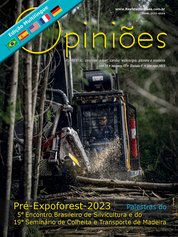Bruno Mariani
Acionista e Diretor geral da Symbiosis
OpCP72
Restauração com fins econômicos, como fazer?
Com o aumento da temperatura global, muitos concordam que precisamos plantar florestas, mas poucas iniciativas têm buscado soluções com o uso de árvores nativas dos nossos biomas, e menos ainda com a visão de encontrar a melhor e mais eficiente forma de fazê-lo.
A silvicultura no Brasil tem, ao longo dos últimos 100 anos, se dedicado a adaptar e a melhorar a produtividade das árvores de outros países. Nada contra, muito pelo contrário. Desde 2006, após deixar 20 anos de mercado financeiro para trás, resolvi investigar a silvicultura com árvores nativas para a produção de madeira serrada, dado a enorme vantagem comparativa do Brasil: grande disponibilidade de terras degradadas em regiões onde florestas existiam no passado, preços competitivos e clima tropical que permite o crescimento das árvores o ano todo. Durante esse processo, me surpreendi com a inexistência de informações confiáveis sobre as nossas espécies madeireiras. As poucas pesquisas e iniciativas em universidades e centros de pesquisa são incompletas, sem longa duração e insuficientes para se fazer uma projeção financeira confiável.
Meu objetivo se tornou, então, desenvolver um plano de negócio que permitisse o surgimento de uma indústria florestal focada na produção de madeira serrada que fizesse frente à devastação desenfreada que já liquidou a Mata Atlântica e que destrói a Amazônia sem agregar valor e prosperidade à população. O desafio é produzir madeira de alta qualidade com árvores nativas e, ao mesmo tempo, restaurar as reservas legais e áreas de proteção permanente, tão importantes para a produção de serviços ambientais.
O mercado conhece a alta qualidade das madeiras de espécies da Mata Atlântica e da Amazônia, que foram extraídas e consumidas no Brasil e no mundo ao longo dos séculos. No entanto, quase nenhum esforço foi feito para entender as características dessas plantas, como cultivá-las, qual a sua velocidade de crescimento, qual arranjo ideal para plantá-las em consórcios florestais, e qual o potencial de aumentar a sua produtividade e melhorar sua forma.
Para alguém que desconhecia o ramo, chamou-me a atenção a falta de curiosidade e imaginação, mas especialmente a incrível oportunidade que se apresentava. Ao investigar a história dos países do hemisfério norte, que devastaram as suas florestas naturais quase que completamente há trezentos anos, e ao constatar que hoje lá existe uma indústria de madeira serrada muito bem estruturada e lucrativa, baseada em reflorestamento e condução de regeneração, ficou claro para mim que o reflorestamento com espécies nativas de alto valor comercial seria uma grande oportunidade de negócio para o Brasil.
O sucesso da indústria de papel e celulose no Brasil, que conquistou o mundo com os saltos de produtividade no plantio do eucalipto, indicava o caminho: investir em melhoramento florestal, entender a silvicultura, domesticar nossas espécies, além de encontrar a melhor forma de combiná-las em consórcios. Nossas espécies precisam de condições ecológicas específicas para se desenvolverem plenamente, algumas necessitam de sombra parcial no início de sua vida e outras se desenvolvem bem a pleno sol. Ao combiná-las em linhas alternadas, podemos maximizar a qualidade do fuste e do desenvolvimento. Adicionalmente, o uso de espécies madeireiras leguminosas fertiliza o solo beneficiando o conjunto do consórcio.
Além disso, a combinação de diversas espécies em consórcio atende à estratégia de diversificação do risco financeiro e biológico como em um portfólio de ativos com risco balanceado. Para a diversificação do risco comercial, é necessário contar com um "portfólio florestal” que tenha madeiras de diversas cores, densidades e utilidade.
Face ao pouco conhecimento silvicultural das nossas espécies, nada mais natural do que estudar dezenas de espécies de alto valor comercial e selecioná-las até se encontrar as espécies ideais. Outro objetivo importante é produzir com biodiversidade. Com o uso de espécies nativas em áreas de produção e de conservação, na última, usando dezenas de espécies sem fins madeireiros, buscamos o impacto positivo na fauna e no solo. Nos últimos 12 anos, temos feito inventários regulares de vertebrados e invertebrados que comprovam a grande diversidade da fauna em nossas áreas e confirmam a nossa missão: “Atender à necessidade da sociedade por produtos madeireiros sem alterar os mecanismos pelos quais os ecossistemas se sustentam”.
Nos últimos 12 anos, foi implantado em escala piloto um grande laboratório a céu aberto com 1.500 hectares, onde foram testados espécies, espaçamentos, correção de solo, adubação convencional e verde, entre outros. Ao mesmo tempo, foi necessário formar uma equipe profissional, mesclando experiência, juventude, excelência acadêmica, conhecimento silvicultural, domínio de equipamentos, maquinário, gestão financeira e administrativa. Durante esse tempo, a gestão financeira e contábil foi auditada por empresas internacionais, para que houvesse confiança nos custos, nos processos e na governança, criando uma metodologia de gestão profissional na busca da excelência a longo prazo.
Em 2017, uma vez acumulados dados de inventário suficientes, duas organizações internacionais examinaram, modelaram e comprovaram o modelo econômico, usando as projeções do fluxo de caixa descontado, usando preços de madeira de bases de dados de longo prazo disponíveis no Brasil e no exterior, dados esses de madeira tropical de desmatamento.
Uma vez comprovado o modelo econômico, segue-se, então, na direção do novo desafio do modelo: a expansão com a compra e implantação de novas áreas para se chegar de forma eficiente a uma maior escala. Para ser bem sucedido no enorme desafio que se segue, foram definidos protocolos e prescrições, e incorporados sistemas de controle de operações, acompanhamento de rendimentos e custos integrados ao sistema contábil e financeiro, trazendo segurança na tomada de decisão, da busca da diversificação de receitas, ganho de escala e melhorias de eficiência.




